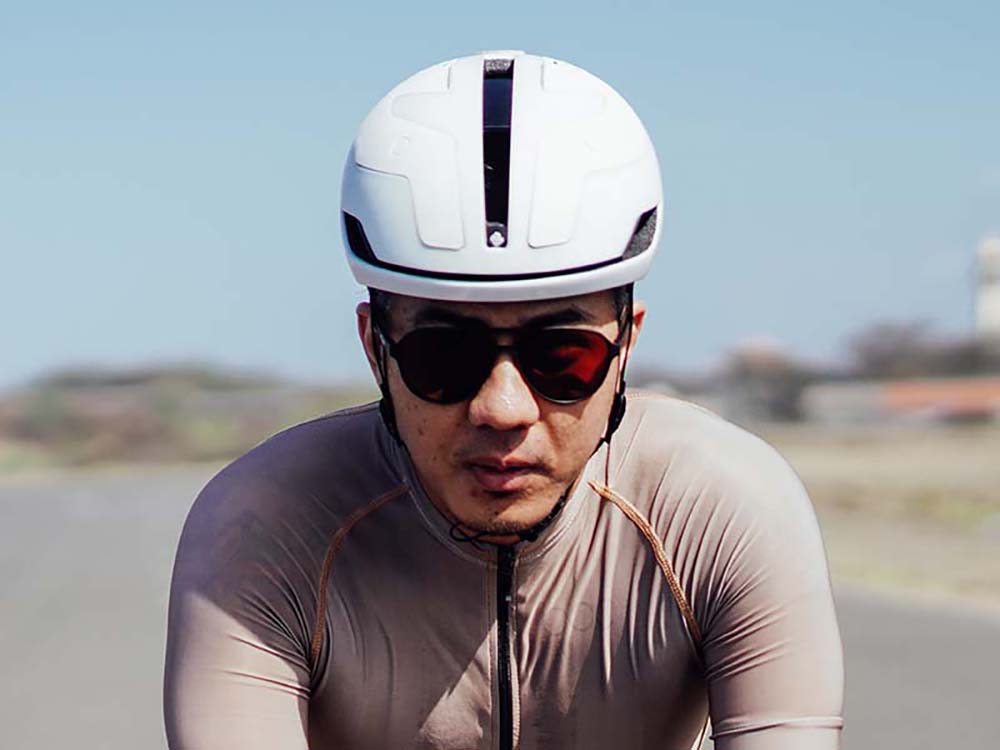Choosing a road cycling helmet: 6 factors for safety and comfort
As you cycle through bustling streets and scenic routes, it becomes vital that you protect yourself with the right equipment. A road cycling helmet is one piece of equipment that should never be overlooked. A well-fitting and high-quality helmet can provide the critical protection your head needs in the event of a crash or accident.
With so many options to choose from, selecting the right helmet can be understandably overwhelming. However, by approaching the process with a progressive mindset and considering the key factors discussed in this guide, you will be empowered to choose a helmet that not only provides optimal safety but also enhances your overall road cycling experience.

What is a road cycling helmet?
A road cycling helmet is a safety precaution designed specifically to provide head protection and safety for cyclists on paved roads. Wearing a helmet is essential for safety and protection while road cycling. Head injuries can have serious consequences and road helmets are an important barrier between the head and a potential impact.
Road Cycling The primary purpose of a helmet is to protect the head in the event of a crash or impact, reducing the risk of serious head injuries. These helmets are streamlined and well-ventilated to keep riders cool and comfortable on long rides.
6 Factors to Consider When Choosing a Road Cycling Helmet
When you find road cycling helmets, they are usually lightweight and aerodynamically shaped to minimise wind resistance and improve cyclist performance. Keep in mind that there are 6 factors to consider when choosing a road cycling helmet.
1. Fit and comfort
The most important aspect of a road cycling helmet is how well it fits your head. Look for a helmet that is secure and comfortable. Consider the shape of your head and choose a helmet that matches it. Look for adjustable retention systems and sizing mechanisms that allow you to customise the fit. The helmet should sit horizontally on your head with the front edge above your eyebrows.
2. Ventilation
Consider the helmet’s ventilation system, especially if you ride in warm or humid climates. Look for a helmet with enough ventilation channels and vents for proper airflow. Good ventilation helps keep your head cool and comfortable on long rides, reducing the risk of overheating and discomfort.
3. బరువు
The weight of your helmet can significantly affect your comfort and performance. Lighter helmets tend to be more comfortable when worn for extended periods of time and can reduce fatigue. Look for helmets made from lightweight materials that don’t compromise safety and protection.
4. Aerodynamics
If speed and performance are your top priorities, consider looking into helmets with aerodynamic designs. These helmets are specifically designed to reduce wind resistance and improve airflow around the head. While they may sacrifice some ventilation, they can provide speed and performance benefits during races or high-intensity riding.
5. Additional safety features
Some helmets have additional safety features such as MIPS (Multi-Directional Impact Protection System) MIPS technology provides an additional layer of rotational force protection during certain types of impacts. If safety is your primary concern, consider a helmet with MIPS or similar technology.
6. Price
Set a budget for your helmet purchase and look for options within that range. Keep in mind that while higher priced helmets may offer advanced features and quality materials, there are also quality helmets available at lower prices. Focus on finding a helmet that meets your specific needs and provides the necessary safety and comfort within your budget.
Find the best helmet at the best price
3 Types of Road Bike Helmets
As far as types are concerned, there are three main categories of road bike helmets that cyclists can choose from:
1. traditional road cycling helmets
These helmets are the most common type for road cyclists. They feature a lightweight, streamlined design that focuses on aerodynamics and ventilation.
Benefits: optimal airflow keeps riders cool, comfortable and sweat-free on long rides. Lightweight construction reduces fatigue. Good protection for general road riding.
CONS: May not provide the same level of aerodynamic performance as dedicated aero helmets. Less emphasis on reducing wind resistance.
Price range: $80 to $300 depending on brand, features and materials used.
2. Aviation road helmets
Aero road helmets are specifically designed to minimise wind resistance and maximise speed. They have a more compact and streamlined shape than traditional road cycling helmets.
Benefits: enhanced aerodynamics for speed and performance. Stylish and aggressive design. Ideal for riders focused on maximising speed and reducing wind resistance.
Cons: Poor ventilation may lead to increased heat build-up during aggressive riding. Limited adjustability due to streamlined design.
Price range: $150 to $500, depending on brand, aerodynamic properties and materials used.

Mastering Road Bike Helmet Care: Pro Tips for Optimal Performance
When it comes to road cycling, a helmet is more than just an accessory; it’s an important factor in ensuring your safety on every ride. Proper care and maintenance of your road cycling helmet is crucial. In this guide, we’ll present expert tips to improve the performance of your helmet and ensure that it remains your reliable guardian when you’re riding at high speeds.
I. Choosing Wisely: The Best Choice of Helmet
Choosing the right helmet is the foundation of safety and comfort:
A. The right helmet
Fit: Ensure a comfortable, secure fit without any unwanted pressure points.
Adjustment of straps: Fine adjustment of the straps to achieve a balanced and comfortable fit.
B. Ventilation and comfort
Ventilation design: Choose a helmet with efficient ventilation to keep your head cool during long rides.
II. Regular Inspection to Ensure Safety
Regular inspections help to prolong the life of the helmet and improve its effectiveness:
A. Structural integrity
Inspect the shell: Inspect the shell periodically for cracks or signs of wear.
Evaluate straps: Check straps for wear or weakness; replace as necessary.
B. Retention Systems
Check retention system: Ensure retention system is functioning properly and provides optimum stability.
III. Ceremonial Cleaning: A Shiny Helmet
Keeping it clean is not only a matter of aesthetics, but also of hygiene and functionality:
A. Quick cleaning
Post-ride wipe: After each ride, wipe the exterior with a damp cloth to remove perspiration and dirt.
Vent cleaning: Remove debris from vents with a soft bristle brush.
B. Deep Cleaning
DISASSEMBLY MAINTENANCE: Periodically disassemble removable parts for thorough cleaning.
HAND WASHING PADS: Gently wash the inner pads by hand to remove perspiration and odours.
IV. Storage Wisdom
Proper storage ensures that the helmet remains in optimum condition:
A. Protection from the elements
Protect from sunlight: Store your helmet out of direct sunlight to prevent deterioration of the material.
Dry storage: Make sure the helmet is completely dry before storing.
V. Expert Keyword Optimisation for Better Visibility
Our guides are strategically keyword optimised to increase their visibility. Targeted keywords include “road bike helmet care”, “helmet maintenance tips” and “cycling safety essentials”.
తీర్మానం
When choosing the right road cycling helmet, it is vital to prioritise safety and comfort on the road. Consider factors such as fit, comfort, ventilation, weight, aerodynamics, additional safety features and price to make an informed decision.
If you want to know more about Shuangye electric bikes or have any questions about our electric bikes/smart helmet and their components, దయచేసి మా కస్టమర్ సేవను చేరుకోవడానికి సంకోచించకండి. మీకు సహాయం చేయడానికి మేము ఎల్లప్పుడూ ఇక్కడ ఉన్నాము.
 shuangye బాహ్య ఉత్పత్తులు
shuangye బాహ్య ఉత్పత్తులు
